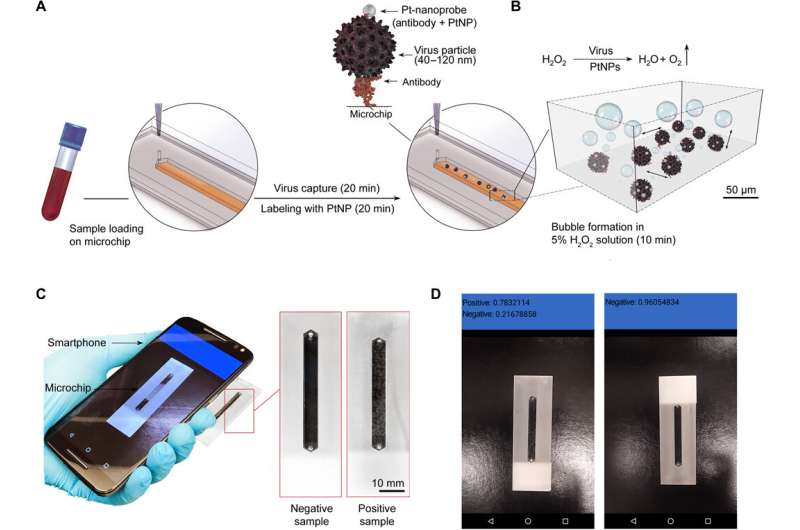Three-dimensional schematic of the CNN–nanoparticle-enabled smartphone for virus detection. The detection process comprises three main steps. (A) Virus capture and labeling using Pt-nanoprobes. The samples are loaded into microchips modified with mAbs against the virus envelope protein and incubated to allow the capture of target virus for 20 min. The captured virus particles are then labeled with Pt-nanoprobes within 20 min. Each step of on-chip virus capture and labeling is followed by a washing step using 10 mM phosphate buffer (pH 7.4) (B) Catalyzer solution containing hydrogen peroxide (H2O2) is added to the chip and incubated for 10 min. In the presence of the captured virus, Pt-nanoprobe complex bubbles (oxygen) are formed because of the catalytic activity of PtNPs in contact with H2O2. Scale bar is set on the basis of the microchip dimensions. (C) The on-chip bubble signal is detected using the CNN–nanoparticle-enabled smartphone (NES). Photo credit: Mohamed S. Draz, Brigham and Women’s Hospital. (D) Screenshots of the results shown by the CNN-NES. Photo credit: Mohamed S. Draz, Brigham and Women’s Hospital. Credit: Science Advances (2020). DOI: 10.1126/sciadv.abd5354
A team of researchers at Brigham and Women's Hospital, Harvard Medical School, has developed a way to use a smartphone camera to test for viral infections. In their paper published in the journal Science Advances, the group describes their system, which also involves the use of an external catalytic microchip device and a smartphone system that uses a trained deep learning algorithm.
As the pandemic has gripped the world for most of this year, scientists have been looking for ways to slow the spread of the next one. In this new effort, the team in Massachusetts has developed a smartphone-based system that can be used by non-medical people to test for a variety of viral infections.
The system is made up of a smartphone, an external catalytic microchip device and software. Body fluid samples are placed into a channel on the catalytic microchip device, which is then doused with a small amount of hydrogen peroxide. The resulting reaction leads to the formation of bubbles. The bubbles develop in unique patterns based in part on viruses in the fluid sample. The user points their smartphone camera at the bubbling sample and launches the deep-learning algorithm that has already been trained to identify the patterns and thereby recognize the presence of viruses. The whole process takes approximately 50 minutes. The researchers have thus far taught their system to recognize just three viruses, Zika and hepatitis B and C. But testing shows the system to be 99% accurate. They note that their system is more portable and cost effective than other solutions in the works.
The researchers suggest that their system could be rapidly trained to recognize new viruses if the need arises, and the catalytic microchip device could be sent to hot spots in the future. Such technology, the researchers suggest, could help to stop future pandemics if used widely. The researchers also note that the system could be immediately useful in infection prone areas lacking testing labs, such as third world countries.
More information: Mohamed S. Draz et al. Virus detection using nanoparticles and deep neural network–enabled smartphone system, Science Advances (2020). DOI: 10.1126/sciadv.abd5354
Journal information: Science Advances
© 2020 Science X Network
























